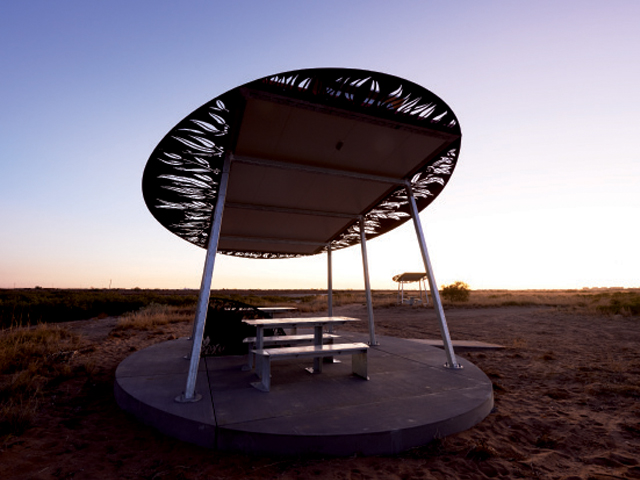These road rest stops in the Pilbara region create a tangible sense of place within contrasting settings, and are successful due to their simplicity and practicality.
In 2014, Urban Art Projects (UAP) was called upon to design and fabricate road rest stops at 11 different locations throughout the Pilbara region in West Australia. These locations included: Halfway Bridge; Hamersley Gorge; Old Onslow Township; Robe River; 40 Mile; Miaree Pool; West Peawah; FMG Rail Lookout; 6 Mile; Cape Keraudren; and Marble Bar Road. UAP had the role of lead consultant for the project.
The design called for shelter structures with no aesthetic limitations. Shelters had to meet all appropriate Australian Standards, including notably cyclonic wind loads. The shelters also required seating for at least eight people and some locations required toilet facilities and waste disposal systems. Universal access to all shelters was mandatory.
UAP engaged Australian designer Kylie Bickle, who created a concept for a modular shelter system suiting specific requirements on each site. These shelters will incorporate artworks from local indigenous artists, which were selected through a collaborative workshop with FORM.
The challenge of this project was to discern themes that result in the creation of a tangible sense of place within contrasting settings. The Pilbara Road rest stop sites are positioned within strikingly different landscapes, but for reasons of economy and practicality a single response was proposed, with considerable scope for adaptation to each location.
The first theme is Shelter. On a purely functional level, the designs will provide relief from the elements of sun, wind and torrential rain.
The second theme is Reflection. On an intuitive level, the designs will highlight and enhance the experience of the elements as manifest in the landscape by providing ‘pools’ of cool shade; utilising sunlight to create decorative overlays; blending into the landscape by day; illuminating with vibrant LED colour at night; and remaining high and dry during periodic flooding.
Indigenous Connection - symbols, as seen in Australian Aboriginal art, are the visual representation or recording of significant information. A series of concentric circles represents a meeting place, campsite or waterhole. A series of parallel lines represent a journey, a path or a means to get there.
The third theme is Connection. Many Indigenous artists express their deep connection to country by documenting the landscape features of their ancestral lands. As we become more accustomed to viewing the planet through satellite imagery, this representation of topography within Aboriginal artworks becomes self evident.
The overarching form of the designs manifests the concept of connection; the road stops themselves being modern day meeting places for people journeying through the Pilbara. Local Aboriginal heritage will also be specifically represented within the designs through the integration of artwork overlays.
There are three primary features expressed within the designs: gentle, undulating curves; waterhole forms; and raised platforms.
The success of the designs lies in the simplicity and practicality of a component system that meets the requirements of the brief in regard to durability, suitability and adaptability. Extensive consideration has been given to the logistics of the road stop structures, including the potential for variation between sites and ground conditions.
For this reason all components, including footings and floors have been designed as pre-fabricated components to be delivered to site and installed quickly, with minimal ground work preparation (levelling and compacting only) This eliminates the need to pour in situ concrete in remote locations, and minimises impact on the Pilbara landscape. Should the future need arise, components can be disassembled, relocated or completely removed.
The Shelter design plays an important role in placing the Pilbara at the forefront of community development in Western Australia, ensuring it becomes a recognised destination with strong local distinctiveness, in addition to providing a vibrant cultural life for residents and visitors. The development and implementation of well considered, unified artworks across the different sites will provide positive social and cultural dividends.
Website
Send Enquiry To Urban Art Projects



